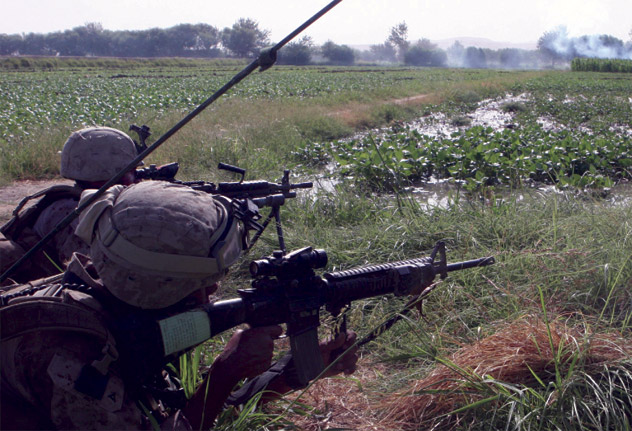McChrystal Calls Marjah a Bleeding Ulcer
BY Herschel SmithFrom Military.com:
Army Gen. Stanley McChrystal, the top allied military commander in Afghanistan, sat gazing at maps of Marjah as a Marine battalion commander asked him for more time to oust Taliban fighters from a longtime stronghold in southern Afghanistan’s Helmand province.
“You’ve got to be patient,” Lt. Col. Brian Christmas told McChrystal. “We’ve only been here 90 days.”
“How many days do you think we have before we run out of support by the international community?” McChrystal replied.
A charged silence settled in the stuffy, crowded chapel tent at the Marine base in the Marjah district.
“I can’t tell you, sir,” the tall, towheaded, Fort Bragg, N.C., native finally answered.
“I’m telling you,” McChrystal said. “We don’t have as many days as we’d like.”
The operation in Marjah is supposed to be the first blow in a decisive campaign to oust the Taliban from their spiritual homeland in adjacent Kandahar province, one that McChrystal had hoped would bring security and stability to Marjah and begin to convey an “irreversible sense of momentum” in the U.S.-led campaign in Afghanistan.
Instead, a tour last week of Marjah and the nearby Nad Ali district, during which McClatchy Newspapers had rare access to meetings between McChrystal and top Western strategists, drove home the hard fact that President Obama’s plan to begin pulling American troops out of Afghanistan in July 2011 is colliding with the realities of the war.
There aren’t enough U.S. and Afghan forces to provide the security that’s needed to win the loyalty of wary locals. The Taliban have beheaded Afghans who cooperate with foreigners in a creeping intimidation campaign. The Afghan government hasn’t dispatched enough local administrators or trained police to establish credible governance, and now the Taliban have begun their anticipated spring offensive.
“This is a bleeding ulcer right now,” McChrystal told a group of Afghan officials, international commanders in southern Afghanistan and civilian strategists who are leading the effort to oust the Taliban fighters from Helmand.
“You don’t feel it here,” he said during a 10-hour front-line strategy review, “but I’ll tell you, it’s a bleeding ulcer outside.”
Throughout the day, McChrystal expressed impatience with the pace of operations, echoing the mounting pressure he’s under from his civilian bosses in Washington and Europe to start showing progress.
Is this a bad joke or a sorry episode of The Twilight Zone? It’s a serious question. Names are supplied, so the author apparently doesn’t mind us fact-checking him. Is this report for real? Did McChrystal really say those things and interact with another officer in this manner? Seriously? This is an important milestone in the campaign. Apparently, we now know the real expectations for the campaign. No one can seriously continue to claim that the withdrawal date is a mere ruse for the American public. They really believe it. They really intend for it to obtain.
Did General McChrystal not cover the basics of classical counterinsurgency doctrine with his civilian bosses? Did he or any of his reports mislead the administration into believing that Marjah or any other town in Afghanistan would be pacified in 90 days? Did he or his reports – or anyone in the administration – really believe that this government ex machina we brought to Marjah would work?
Forgetting classical counterinsurgency doctrine which normally presumes that COIN will take ten or even more years, for anyone who has been listening and watching for the past several years, the most successful part of the campaign in Iraq, i.e., the Anbar Province, took about three and a half years from the inception of Operation Al Fajr until late 2007 when Fallujah was finally stable at the conclusion of Operation Alljah.
Security in Ramadi preceded Fallujah slightly, Haditha preceded Ramadi by a little and Al Qaim was secure before Haditha. But the whole of the Anbar Province took over three years and the efforts of the best fighting force on earth, the U.S. Marine Corps, in which more than 1000 Marines perished and many more were wounded or maimed. No one in his right mind would claim that the U.S. Marine Corps did not understand or implement a successful strategy in the Anbar Province, where the Marines had to fight their way through an indigenous insurgency (finally co-opting their services) to get to the 80-100 foreign fighters per month flowing across the Syrian border. Iraq is still not entirely stable, and its security will be a direct function of the extent to which we confront Iran in its quest for regional hegemony.
This report is so bizarre, so jaw dropping, and so disturbing, that it naturally leads to many other very important questions. Does McChrystal believe that the COIN operations will be successfully concluded within a year or even a year plus a few months? Did he communicate that to the administration? If so, does the administration believe it? Was time frame ever brought up? Did the administration simply lay down expectations without reference to historical precedent for successful COIN campaigns and without asking General McChrystal?
The notion that Marjah is a bleeding ulcer is preposterous when compared to Ramadi in 2006 or Fallujah in 2007. Someone or some group is not thinking clearly, and this lack of clarity may be the doom of the campaign when it finally becomes apparent to everyone else that we are in the “long war.” It will not be finished for a long time to come, even if America stands down. The enemy gets the final vote.




